1985 British Grand Prix race report - A bit farcical
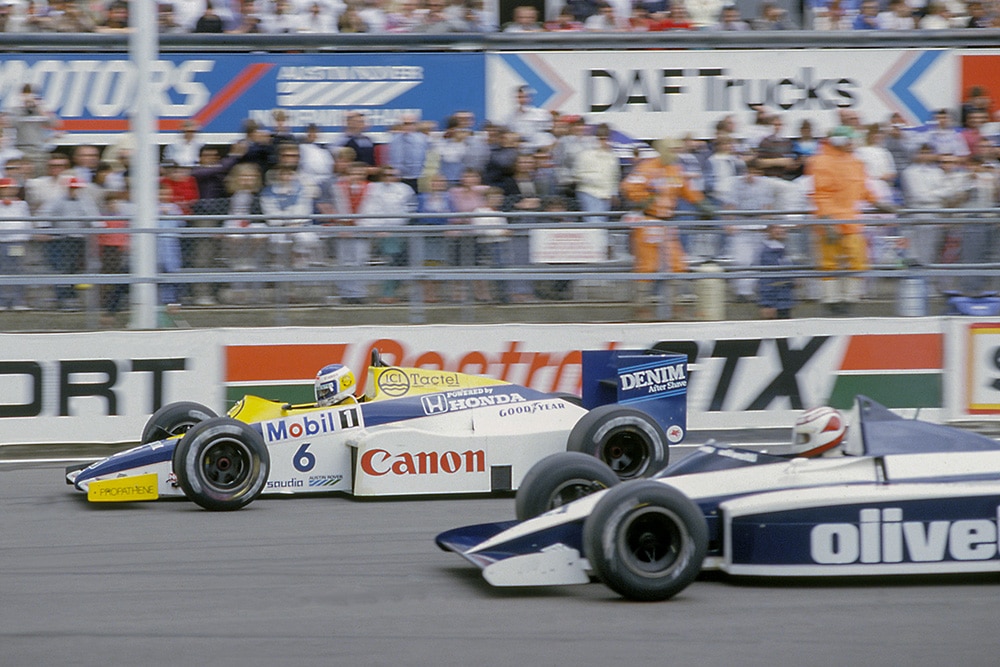
Keke Rosberg (Williams FW10 Honda) leads, Nelson Piquet (Brabham BT54 BMW) at the start, after they qualified 1st and 2nd respectively.
© Motorsport Images
A bit farcical
Silverstone, July 21st
The whole affair started off badly when the Friday morning practice session was delayed by the most appalling weather. It wasn’t that nobody wanted to go out in the rain, but international rules state clearly that official practice cannot start until full medical services are ready and waiting, and these include a rescue helicopter. With the clouds down on the deck all flying around the Silverstone area was off, and the military helicopter that was going to standby officially could not take off from its base nearby, and if it had it could not have got into Silverstone, so no helicopter, no practice.
Everyone kicked their heels all morning and a fairly large crowd of paying customers sat in the Woodcote Grandstands and waited very patiently. About 1 pm there was a break in the clouds, the sun burst through and within minutes the sky turned almost to summer. Racing engines started, the helicopter hove into view and within minutes a very abbreviated “test-season” began, to sort out tyres, aerodynamics, gear ratios and suspension settings all in a mad rush.
The vast programme of events planned for the day was now three hours behind schedule and nobody envied the job of the clerk of the course who had to re-schedule everything and try and make the best of the situation. Something like 20 minutes was allowed for testing, then there was a 10 minute break and then the Friday one hour of qualifying. The short test-session was enough for Patrese’s Alfa Romeo to expire in a cloud of smoke as a turbocharger failed and for the Lotus team to disintegrate into a right old shambles. Senna’s 97T Lotus went wrong in its Renault engine department, and the spare car was set up ready for the afternoon qualifying, so there was a mad rush to get it ready for him to use for tyre testing etc. By the time he went out on “wet” tyres the track had dried so he was straight back in again. Nobody was really organised or under control during this hurried 20 minutes, but they all made the best they could, paused for 10 minutes and then we were away on marked tyres to qualify for grid positions.
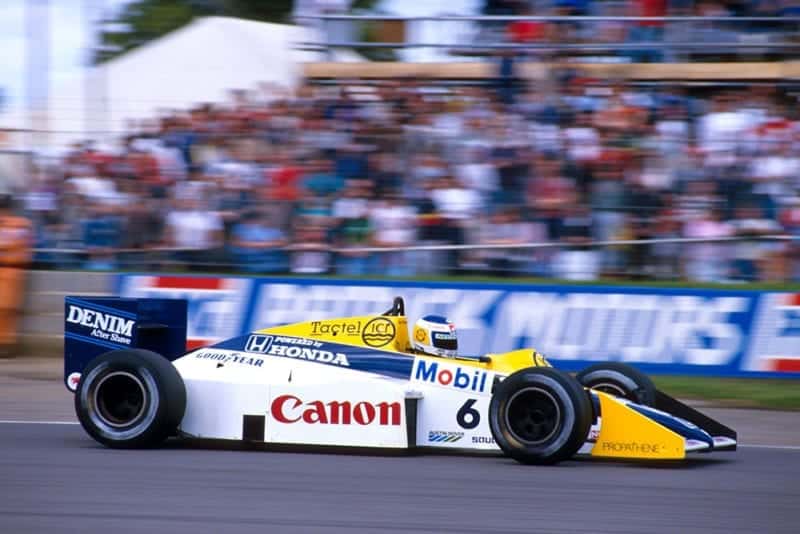
Keke Rosberg (Williams FW10 Honda) who’s pole position time was the fastest ever qualifying lap.
© Motorsport Images
The rain held off and the track was reasonably dry so some fast motoring began. As always the fast cars and drivers were up the front and the slow cars and drivers were at the back. If we started a qualifying session with no prior practice or testing it probably would give the some answer, apart from obvious trouble. Early in the year it was estimated that the fast laps would be in the region of 155 mph average, bearing in mind that the Formula One cars have not raced at Silverstone since 1983, but then in pre-race tyre testing a few weeks before the meeting laps of 157 mph were recorded so that this first qualifying session started with 160 mph as the target figure, a time of just under 1 min 06 sec for the three mile circuit, and that figure is quite a good one for club racing on the short circuit!
For nearly half-a-hour Rosberg, Prost, Alboreto and de Angelis were trying for pole position and the average passed 157 mph, then passed 158 mph and Rosberg and Prost were in with 159 mph. At this point Senna was not even on the score-board, a Renault engine had gone wrong again, this time in the tweaked-up T-car and the shambles continued as everyone worked frantically to get his race-car set up for one-lap dash. Meanwhile the young Brazilian stood by impassively, then got in the car and waited patiently, and with qualifying half-way through he went out, first of all on race-tyres to see if all was well, and immediately moved up to ninth on the grid. Then he jumped to fourth, and after a change to soft qualifying tyres he was third with a 159 mph lap, to join Rosberg and Prost at the top of the list. Their times were Rosberg with the Williams-Honda 1.06.107, Prost with the McLaren-Porsche 1.06.308 and Senna with the Lotus-Renault in 1.06.3.24. Rosberg had changed to the Williams T-car as his own had clutch trouble, and in the dying minutes snatched FTD in a heroic drive that was right on the limit all the way round. His time gave an average speed of 159.668 mph; so near and yet so far.
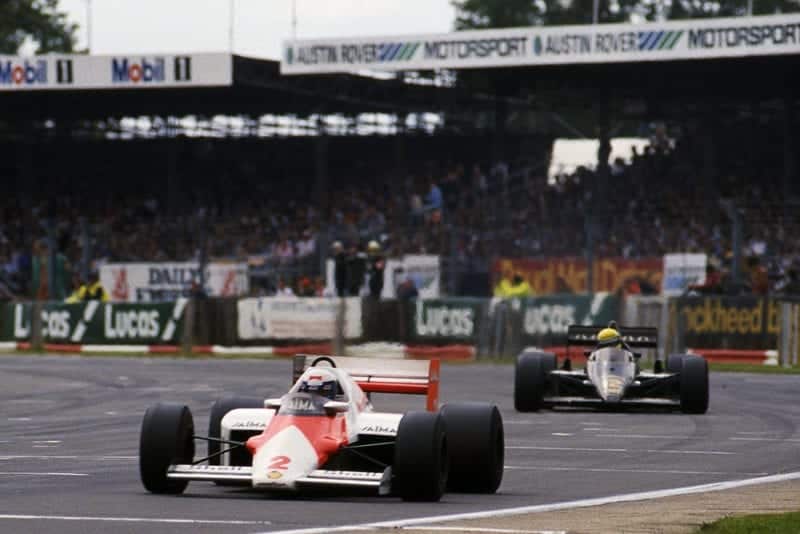
Alain Prost (McLaren MP4/2B) leads Ayrton Senna (Lotus 95T).
© Motorsport Images
Others merely had trouble. Mansell’s clutch expired (Williams-Honda was using modified clutches to cope with the Honda power, as well as a single plenum chamber on top of the engine intakes) and he came to rest in a cloud of smoke opposite the pits. Brundle made a cloud of smoke by the pits as well, but it was tyre smoke as’ he spun. The Tyrrell Renault turbo stayed in the middle of the track, Brundle kept the engine running, caught the car at the end of its 360- degree gyration and carried on. In spite of the mad haste in which everything had to be done, the qualifying hour went off remarkably well and says a lot for the way the various teams work and are able to improvise and adapt to varying conditions. British industry could learn a thing or two from Formula One teams.
On Saturday things returned to normal, the weather was pretty good and the whole schedule of events ran well to time. There was a pause during the morning test-session while the Minardi was collected from where it had come to rest, in a dodgy spot, and a RAM was gathered up at the same time. Testing continued until 11.30 am during which time everyone tried to decide on the best combination of variables for the afternoon qualifying, and also the best combination for the actual race, especially for the opening laps when fuel tanks are full to the brim.
It was dry and windy when the track was officially open at 2 pm for qualifying and most of the fast runners were soon out having their first go, as the sky was anything but stable and a rain-shower could ruin everything. Lauda did a quick lap, then Piquet, then de Cesaris followed by Johansson and Mansell, and. the times kept coming down, but not as low as expected probably due to the wind.
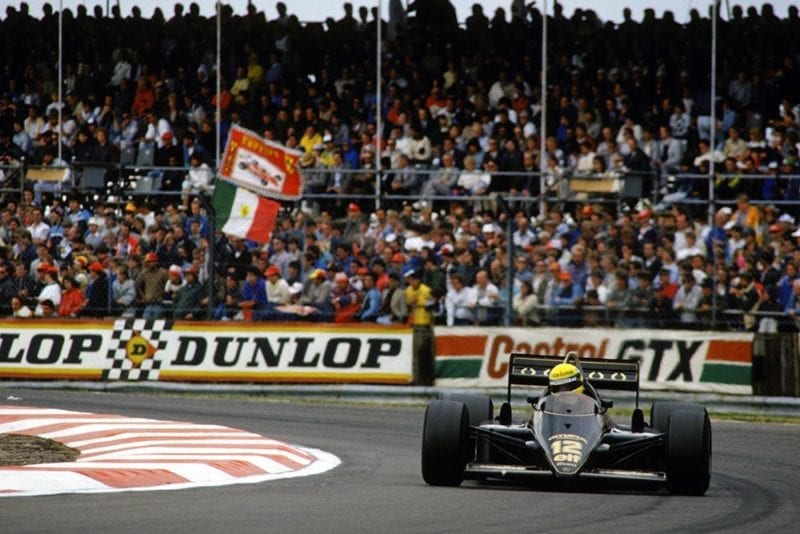
Ayrton Senna in his Lotus 98T retired with fuel injection electronics failure on lap 60.
© Motorsport Images
It was getting almost like Indianapolis qualifying as drivers made individual runs with just the odd one or two “rabbits” scattered around the circuit. So far 1 min 7 sec and a bit was the order of the day, but then Senna went out and did 1 min 06.794 sec. Prost did a 1 min 8 sec, Brundle did 1 min 9 sec, Piquet had done a 1 min 7 sec and then Rosberg went out. Spectacular is a simple word to use, and if you weren’t there to see it it is a great pity. 1 min 5.967 sec as near as dammit 160 mph average round the converted airfield! All this was just the first qualifying runs, they all had a second set of tyres to use, but the weather gods decided enough was enough and the pocket-sized shower sprinkled its way across the Silverstone fields. That seemed to be the end of it, but with 25 minutes still left the sun burst through again and everyone was ready to have another go, even though there were damp patches at Becketts and Stowe.
There was a real flurry of high speed driving in the dying minutes of the hour and Senna, Prost, Piquet, Mansell, Alboreto, de Cesaris, de Angelis and Fabi were all having a real go, but almost as the session finished the incredible Keijo Rosberg was out once more and stood the speed world on its ear with a _lap in 1 min 5.591 sec, an average of 160.925 mph. It was the perfect end to a splendid session of Formula One in action, and even some hardened cynics who don’t think much of Formula One were heard to say “Phew! Quick, aren’t they?” Piquet did 159.326 mph, well back on form in spite of Pirelli tyres, Prost did 159.184 mph, in spite of McLaren International saying how they don’t allow themselves to get embroiled in qualifying battles, Senna did 159.146 mph, in spite of a demon Renault engine that misfired at the top end, and the rest were “slow” – a mere 158 mph, or even as slow as 156 mph average for the 3 mile lap!
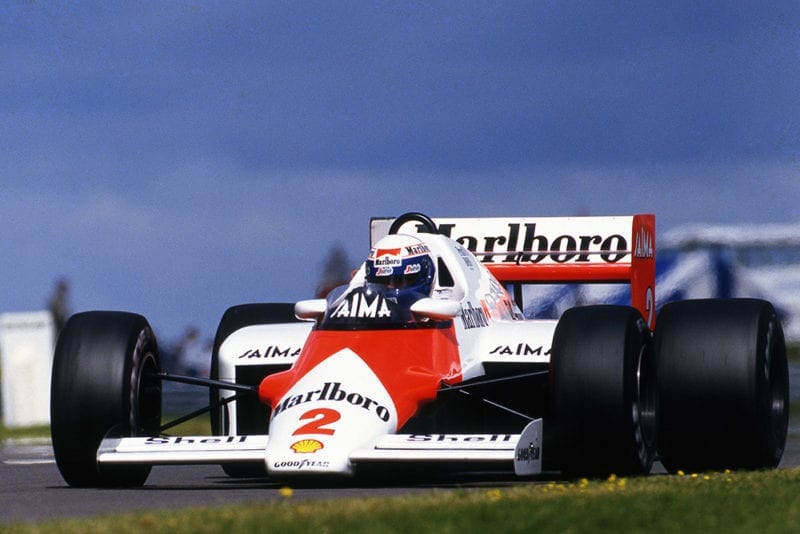
Alain Prost McLaren MP4/2B preserved his fuel better than the rest to claim victory.
© Motorsport Images
Last of the 26 runners was Bellof with the Tyrrell-Cosworth V8 with a paltry 137.804 mph! Remember the great days of the past when we saw the first 100 mph lap at Silverstone, and then the progress through 120 mph, 125 mph and the approach of 150 mph laps? Now we had seen 160 mph and even Rosberg admitted that such average speeds made Silverstone seem a tiny little circuit with no straights at all. For those of us who were there and saw it happen it was a memorable occasion. At the 1983 British GP Rene Arnoux in a Ferrari set pole with a time of 1.09.462, which would have got him into 21st position on this year’s grid! The healthy part of this year’s qualifying was that there were four very different engines powering the cars in the first four places; Honda V6, BMW 4 cyl., Porsche V6 and Renault V6, all 1½-litres capacity with turbochargers forcing the air into the cylinders at anything up to 45 psi or even 50 psi and the power output?
Formula One is serious these days so no engine design team is going to reveal any real figures, but 900 bhp must be coming into view. Some idea of the “grunt” pushed out by these engines is shown by Rosberg’s speed over the finish line, just before the pit wall, being 161 mph, after leaving the chicane at about 125 mph, and reaching 185 mph, even 190 mph before the braking point for Copse Corner. That sort of high-speed acceleration is beyond the imagination of ordinary mortals like you and me.
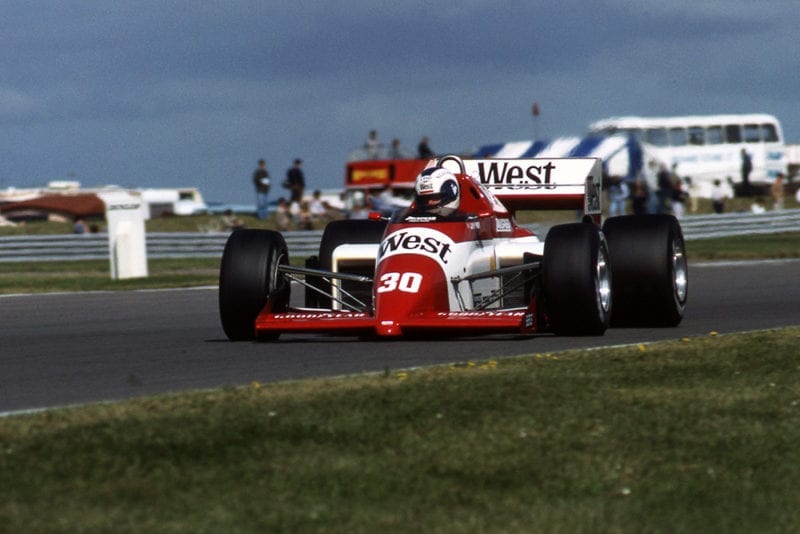
Jonathan Palmer in his Zakspeed 841.
© Motorsport Images
After an afternoon like that there didn’t seem to be much point in returning on Sunday, but nevertheless a huge crowd did return and a very full day of activity was presented by the RACMSA and all its voluntary helpers. It all started at 6.30 am with coach trips round the circuit, and went through “walk about” in the pit lane, Formula 3 racing, Historic racing, air displays, truck displays, parachutes, flag parades, saloon car racing, helicopter displays, music, food and drink which went on officially until 6 pm and unofficially until long after dark. Somewhere amidst all the fun and games the British Grand Prix took place, supposedly over 66 laps of the circuit and lasting all of 1 hour 20 minutes. My friend A.H. and I have a saying, which says “Don’t go to the toilet when the green light is about to come on to start the Grand Prix, or by the time you come out it will all be over.” Compared to Saturday afternoon qualifying the race was a bit of a farce, with a fastest lap at a mere 151 mph and an average speed for the race of 146 mph, but worst of all was the man with the chequered flag who stopped the race at the end of lap 65 instead pf at the end of lap 66.
The organisers put it down to “human error” which really is a nice “circus” touch in this electronic, micro-chip, computer age, where Formula One cars are a mass of hightechnology in order to balance power output against fuel consumption, relative to lap times, in order to complete the scheduled 66 laps, plus the opening parade lap, on the 220 litres of fuel permitted by the regulations. Through all this “high-tech” and electronic time-keeping to 1000th of a second, a man with a flag decides when the race has finished, and he makes “a human error”. It does put it all into perspective, doesn’t it?
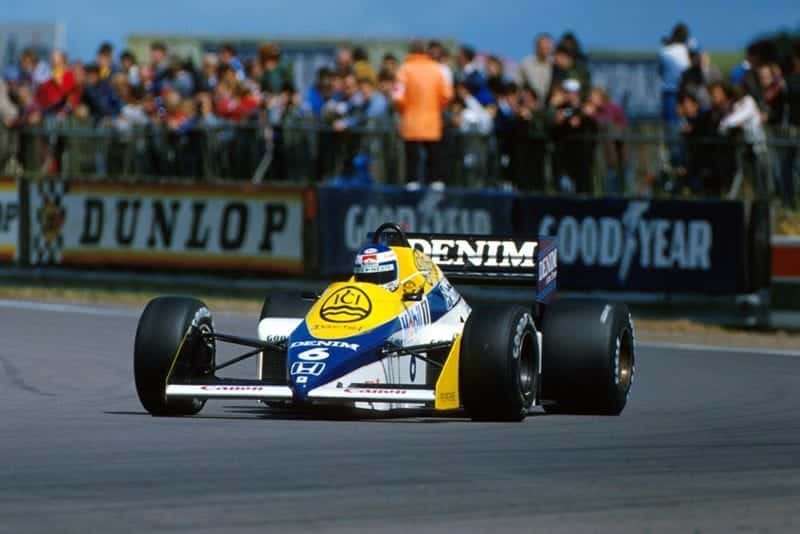
Keke Rosberg in his Williams Honda FW10.
© Motorsport Images
As a motor race there were some super highlights, as well as some low ones, and we saw both within the first half-mile. Ayrton Senna did the sort of start, from his fourth place on the grid, of which Gilles Villeneuve would have been proud. It was perfection and he took the lead as he turned into Copse Corner, leading Rosberg, Mansell and Prost. In midfield Patrick Tambay made a complete nonsense, and spun his Renault RE60B, collecting Johansson’s Ferrari and the chain reaction eliminated Alliot and Ghinzani. From the opening lap it was a two-car race Senna (Lotus) and Rosberg (Williams) running away from the rest of them. Rosberg soon settled for second place, rather than risk wearing his tyres out or using too much fuel. He was in the Williams T-car, having switched just before the start, and with only a third of the race run there was a cloud of smoke from the engine compartment and that was that. His team-mate, Mansell, had gone out with another clutch failure, while Prost had already worked his way by both Williams cars into second place.
A race-long duel ensued between Senna, always in front, and Prost shadowing him, both drivers steeling themselves to keep the turbo boost pressure and conserve fuel on this economy run. Senna was complete master of the situation, even when they came up to lap some fast runners like Alboreto (Ferrari) and Piquet (Brabham). It seemed a case of “stalemate” until on lap 60 the Renault engine in the Lotus suddenly cut out; Prost flashed by into the lead, the Renault engine came on song again and Senna shot back into the lead, but as they started lap 61 it was all over, the Renault engine died completely, out of fuel, and Prost was long gone, carefully reading his fuel gauge to ensure he didn’t use his quota on the next five laps.
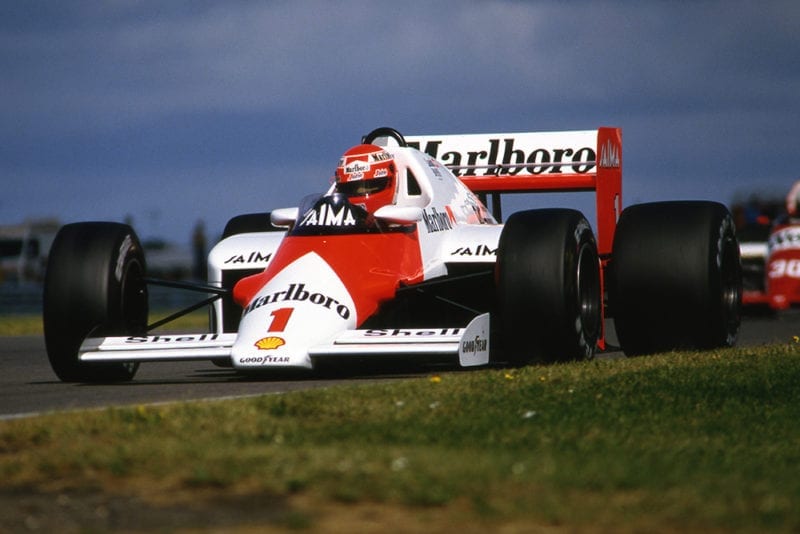
Niki Lauda in his McLaren MP4/2B.
© Motorsport Images
With the flag being shown at 65 laps he was safely home, but he kept on going for another lap, preferring to believe what the McLaren pit were telling him, and came home a worthy victor after a very determined and calculating drive. His team-mate Lauda succumbed to an electronic fault somewhere in his McLaren- Porsche, when he had climbed up to second place, and de Cesaris had retired his Ligier- Renault with clutch trouble after putting on a good race by any standards. Jacques Laffite in the second Ligier had a good race, profiting by other drivers’ troubles and actually caught and passed Piquet’s Brabham-BMW, which was being kept down on power and speed in order to finish. The Ligier actually ran out of fuel on the 66th lap, as did Warwick’s new Renault RE60B, but by then the RACMSA had decided the race finished on lap 65.
So that was it, we had seen a lap at 160 mph in qualifying, a new race lap record of over 151 mph, heroes of the meeting were Prost, Rosberg and Senna. Lucky drivers were Alboreto (second with an ill-handling Ferrari) and Laffite and unlucky ones were Johansson, Ghinzani and Alliot who were put out through no fault of their own, or their teams. Now that we have seen just how fast Silverstone can be, somebody has found out, so that before Formula One returns, there will probably be some sharp corners before the Woodcote chicane, and even before Stowe Corner, so real speed at Silverstone is all over. We might just as well fold it all up and put it all back to arable farming, as it was before “the beetle men” arrived, as T. H. White put it when Silverstone race track first disturbed his hawks. Or we could turn it into a huge housing estate for BRDC members only, with the occasional “street race” where we would know there would be no complaints. Or it could be developed into a huge motoring “leisure centre”. On the other hand, we wept salt tears when the Woodcote chicane was built, not so many years ago, to curb speeds, and here we are with a 160 mph lap. Give the Formula One world a free hand for 10 years and we’ll probably get a 165 mph lap on the proposed revised circuit. You can’t keep good men down, and Formula One has a lot of good men in its ranks, be they drivers, mechÂanics, designers, managers, sponsors or whatever. Formula One for Grand Prix racing is very strong. – D.S.J.
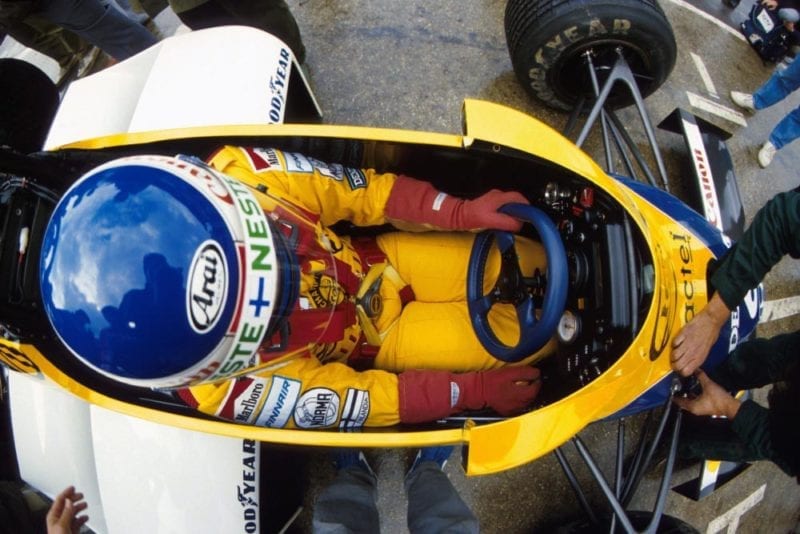
Keke Rosberg sitting in his Williams Honda FW10 .
© Motorsport Images
Results
British Grand Prix – Formula One – 65 laps – Silverstone – 4.71 Kilometres – 306.708 Kilometres – cool and grey
(Race stopped one lap early by error)
1st: Alain Prost (McLaren MP4/2B-2) 1 hr 18 min 10.436 sec. – 235.404 kph (146.274 mph)
2nd: Michele Alboreto (Ferrari 156/85-081) 1 lap behind
3rd: Jacques Laffite (Ligier JS25/05) 1 lap behind – out of fuel
4th: Nelson Piquet (Brabham BT54/3) 1 lap behind
5th: Derek Warwick (Renault RE60B/07) 1 lap behind – out of fuel
6th: Marc Surer (Brabham BT54/3) 2 laps behind
Fastest lap: Alain Prost (McLaren MP4-2B/2) on lap 43 in 1 min 09.886 sec. – 243.067 kph (151.035 mph)
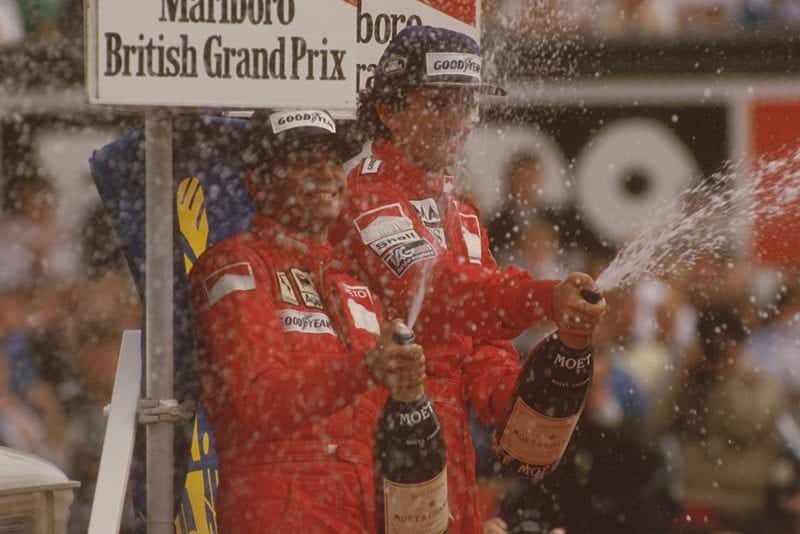
Alain Prost, 1st position, and Michele Alboreto, 2nd position on the podium.
© Motorsport Images
Silverstone Snippets
Martin Brundle raced the Renault powered Tyrrell once more, but when it was late leaving the “dummy-grid” he was forced by rules to start from the back of the 26 car field. He drove a good race to finish seventh.
* * *
Elio de Angelis had a funny old day. An accident in the morning warm-up session meant a lot of hurried work for the Lotus mechanics and then in the race the Renault engine died. Coasting into the pits the Italian decided his race was over but after failing to find anything wrong his mechanics decided to see if the engine would start. It fired-up and ran perfectly so the driver was sent for and put back in the race – 28 laps behind the leader.
* * *
Teo Fabi’s race with the Toleman-Hart was short-lived, from a healthy grid position in the top ten. The final drive oil filter specification had been changed by the outside manufacturer, unbeknown to the team, which caused the oil to run too hot and the crown wheel and pinion suffered.
* * *
Thierry Boutsen had an unfortunate acci- dent out of Becketts Corner when the throttles stuck open on the BMW engine in his Arrows. He was unhurt.
* * *
Stefan Johansson’s Ferrari withstood the collision with Tambay’s Renault far better than the French car. An oil radiator was split on the Ferrari, which caused its retirement, but the Renault lost the right front wheel, hub, brake and upright, which snapped off the wishbones like a carrot.
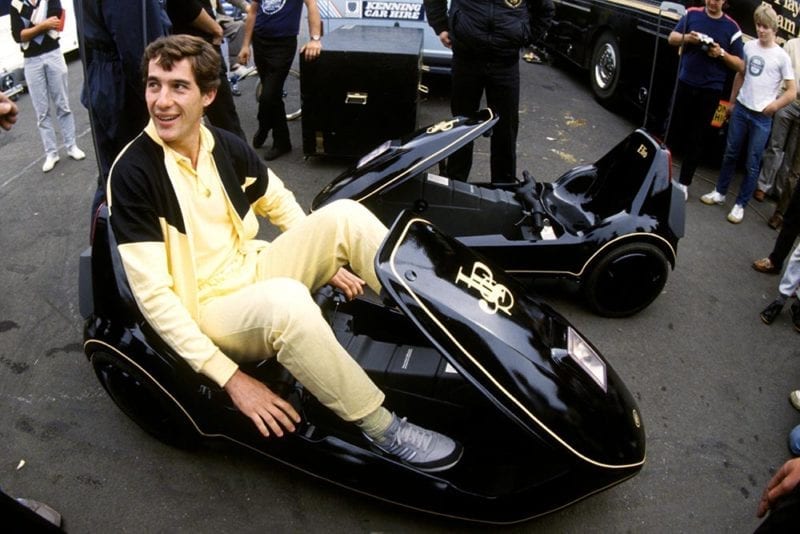
Ayrton Senna Lotus familiarises himself with a JPS liveried Sinclair C5 a revolution in automotive engineering!
© Motorsport Images
